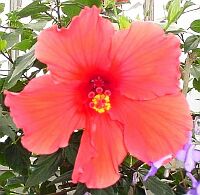San Antonio Express News
GARDENING, Etc.
Sunday, June 1, 2003
This week, Extension shares information with you on one of San Antonio’s most popular summer bloomers. For many years the hibiscus has been a favorite with gardeners in our area due to its adaption to our climate, soil, and water needs. With a little care and feeding the hibiscus will produce beautiful red, white, yellow, peach, orange, and all shade of pink flowers, all summer long. The following article appeared in the June 2002 web issue of Horticulture Update, written by Dr. William C. Welch, Landscape Horticulturist at Texas A&M, edited by Dr. Douglas F. Welsh, and produced by Extension Horticulture.
Chinese hibiscus (Hibiscus rosa sinensis) offer an excellent source of summer color in the landscape, and are among our most popular tropical and subtropical flowering plants. Popularity in Texas appears to be increasing in recent years, although insects, diseases, and winter injury limit their use. Even the southernmost extremes of Texas occasionally experience sufficient cold to kill this plant. With this in mind, hibiscus rosa sinensis should be grown as an annual or container specimen in most of the state. In areas where winter does not cause damage, hibiscus is a perennial, and may be used as a more permanent landscape plant.
The glossy green foliage varies considerably in size and texture among the many varieties. Flowers range from 4 to 8 inches in diameter, and may be double or single. Hibiscus belongto the mallow family and are closely related to cotton, hollyhock, Turks cap, the mallows, shrub althaea, Confederate rose, and okra. Colors vary from white through pink, red, yellow, apricot, and orange. Generally, the single-flower hibiscus bloom more, and, therefore, offer a bigger show in the landscape, but doubles are sometimes preferred for their spectacular individual flowers.
Hibiscus flowers are popular for decoration. They need not be placed in water to prevent wilting, which adds flexibility to their use. An objection is that the flowers of most varieties last only one day, especially during hot weather. To keep flowers open until evening, cut blooms as soon as they are fully open in the morning, and keep in the refrigerator until just before using. If no leaves are pulled with the blossoms, picking does not damage the plant or reduce the total amount of flowering.
Hibiscus prefer a sunny location and well drained soil containing plenty of organic matter and nutrients. From April through September, small monthly applications of a complete fertilizer are beneficial for continuos bloom.. Container-grown plants will require more frequent applications. To bloom and grow profusely, hibiscus must have sufficient water. As with most other plants, watering should be done thoroughly and not too frequently. Some protection from strong winds is necessary, since the flowers are easily damaged. It should be remembered that hibiscus are not cold hardy.
If your area is subject to freezing temperatures, your Chinese hibiscus must either be treated as annuals and allowed to freeze or be protected during cold weather. During mild winters, plants may freeze to the ground and then sprout from the base the following spring. Applying a loose mulch, such as pine straw or oak leaves, around the base of the plant before cold weather sometimes prevents severe winter injury. Certain varieties are more susceptible to cold damage than others. If greenhouse space is available, plants may be dug, placed in containers, and replanted in the landscape after the danger of frost has passed.
In recent years, there has been an increase in use of hibiscus as container plants. Small plants may be purchased early in spring or summer, placed in large pots (at least 12 inches inches diameter) and enjoyed until frost.
Courtesy of Texas Cooperative Extension, The Texas A&M University System, College Station, Texas.

